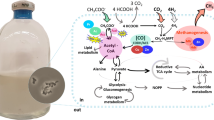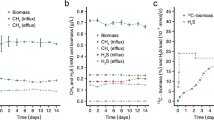Abstract
Methane formation from H2 and CO2 in methanogenic bacteria is a Na+-dependent process. In this communication the effects of Na+ ionophores, of uncouplers, and of Na+/H+ antiporter inhibitors on methane formation from H2 and CO2 were studied with Methanobacterium thermoautotrophicum.
-
1.
Na+ ionophores (the Na+/H+ antiporters monensin and lasalocid and the Na+ uniporter gramicidin) stimulated methanogenesis at lwo external Na+ concentrations when the K+ concentration was high. The ionophores had no effect at high external Na+ concentrations and were inhibitory at low external K+ concentrations.
-
2.
Uncouplers (protonophores and valinomycin plus K+) inhibited methanogenesis at low external Na+ concentration at both low and high external K+ concentrations. Inhibition by uncouplers was relieved by the addition of either Na+ or Na+ ionophores.
-
3.
Na+/H+ antiporter inhibitors (harmaline, amiloride, and NH +4 ) inhibited methanogenesis at low external Na+ concentration. Inhibition was relieved by the addition of either Na+ or of the Na+ ionophores.
The results are discussed with respect to the role of Na transport across the cytoplasmic membrane in methanogenesis from H2 and CO2.
Similar content being viewed by others
References
Bakker EP (1978) Ionophore antibiotics. In: Hahn FE (ed) Antibiotics V 1. Mechanism of action of antibacterial agents. Springer, Berlin Heidelberg New York, pp 67–97
Blaut M, Gottschalk G (1985) Evidence for a chemiosmotic mechanism of ATP synthesis in methanogenic bacteria. TIBS 9: 486–489
Blaut M, Müller V, Fiebig K, Gottschalk G (1985) Sodium ions and an energized membrane required by Methanosarcina barkeri for the oxidation of methanol to the level of formaldehyde. J Bacteriol 164:95–101
Butsch BM, Bachofen R (1984) The membrane potential in whole cells of Methanobacterium thermoautotrophicum. Arch Microbiol 138:293–298
Chen M, Wolin MJ (1979) Effect of monensin and lasaloci-sodium on the growth of methanogenic and rumen saccharolytic bacteria. Appl Environ Microbiol 38:72–77
Daniels L, Sparling R, Sprott GD (1984) The bioenergetics of methanogenesis. Biochim Biophys Acta 768:113–163
Dellinger CA, Ferry JG (1984) Effect of monensin on growth and methanogenesis. of methanobacterium formicicum. Appl Environ Microbiol 48:680–682
Hilpert R, Winter J, Hammes W, Kandler O (1981) The sensitivity of archaebacteria to antibiotics. Zbl Bakt Hyg I Abt Orig C 2:11–20
Jarrell KF, Hamilton EA (1985) Effect or gramicidin on methanogenesis by various methanogenic bacteria. Appl Environ Microbiol 50:179–182
Jarrell KF, Sprott GD (1983a) The effects of ionophores and metabolic inhibitors on methanogenesis and energy-related properties of Methanobacterium bryantii. Arch Biochem Biophys 225:33–41
Jarrell KF, Sprott GD (1983b) Measurement and significance of the membrane potential in Methanobacterium bryantii. Biochim Biophys Acta 725:280–288
Jarrell KF, Sprott GD (1985) Importance of sodium to the bioenergetic properties of Methanococcus voltae. Can J Microbiol 31:851–855
Perski HJ, Schönheit P, Thauer RK (1982) Sodium dependence of methane formation in methanogenic bacteria. FEBS Lett 14:323–326
Pressman BC (1976) Biological applications of ionophores. Annu Rev Biochem 45:501–530
Rottenberg H (1979) The measurement, of membrane potential and Δ pH in cells, organelles, and vesicles. In: Fleischer S, Packer L (eds) Methods in enzymology, vol LV. Academic Press, New York San Francisco London, pp 547–569
Schönheit P, Beimborn DB (1985a) Presence of a Na+/H+ antiporter in Methanobacterium thermoautotrophicum and its role in Na+ dependent methanogenesis. Arch Microbiol 142:354–361
Schönheit P, Beimborn DB (1985b) ATP synthesis in Methanobacterium thermoautotrophicum coupled to CH4 formation from H2 and CO2 in the apparent absence of an electrochemical proton potential across the cytoplasmic membrane. Eur J Biochem 148:545–550
Schönheit P, Perski HJ (1983) ATP synthesis driven by a potassium diffusion potential in Methanobacterium thermoautotrophicum is stimulated by sodium. FEMS Microbiol Lett 20:263–267
Schönheit P, Moll J, Thauer RK (1980) Growth parameters (Km μmax, Ym) of Methanobacterium thermoautotrophicum. Arch Microbiol 127:59–65
Schönheit P, Beimborn DB, Perski HJ (1984) Potassium accumulation in Methanobacterium thermoautotrophicum and its relation to the electrochemical proton gradient. Arch Microbiol 140: 247–251
Wildenauer FX, Blotevogel KH, Winter J (1984) Effect of monensin and 2-bromoethanesulfonic acid on fatty acid metabolism and methane production from cattle manure. Appl Microbiol Biotechnol 19:125–130
Author information
Authors and Affiliations
Rights and permissions
About this article
Cite this article
Schönheit, P., Beimborn, D.B. Monensin and gramicidin stimulate CH4 formation from H2 and CO2 in Methanobacterium thermoautotrophicum at low external Na+ concentration. Arch. Microbiol. 146, 181–185 (1986). https://doi.org/10.1007/BF00402348
Received:
Accepted:
Issue Date:
DOI: https://doi.org/10.1007/BF00402348




